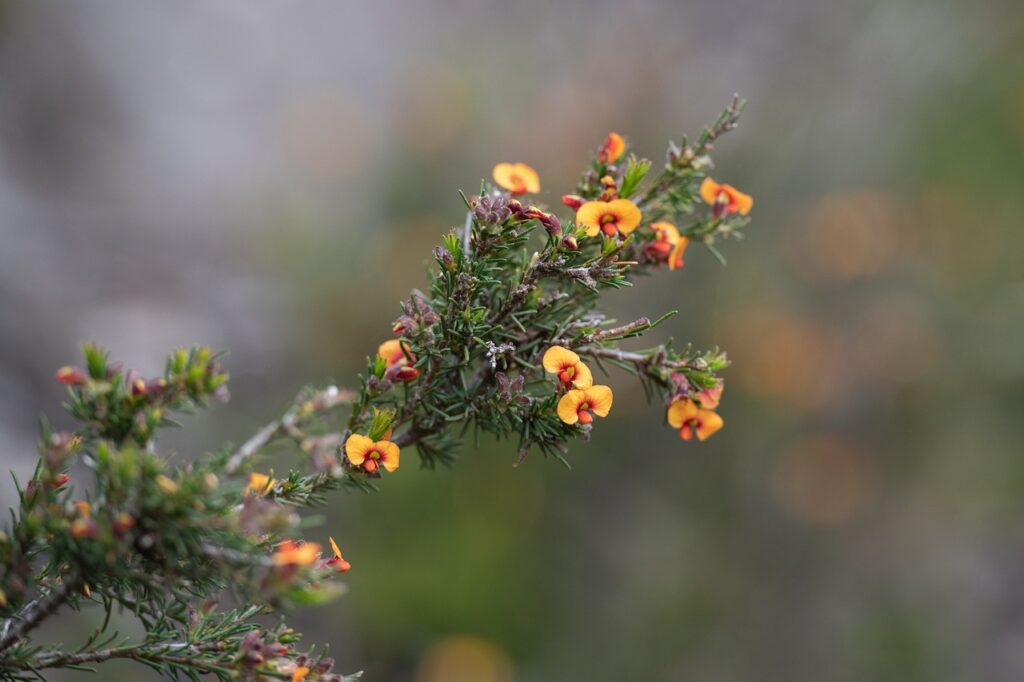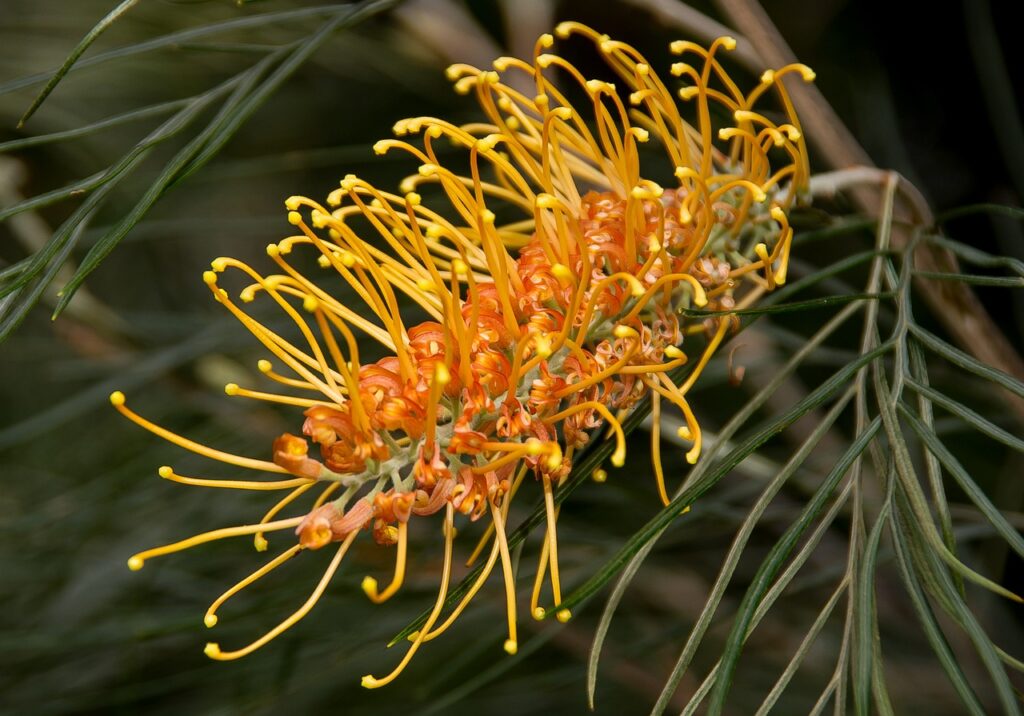Australia is a country with diverse climate conditions and a vast area of land. Surviving in the unique ecosystem of Australia demands a lot of mechanisms for adaptation and survival.
Australian shrubs are popular in everyday horticulture due to their toughness. The Australian shrubs come in various shapes, colors, and sizes, making room for a diversity of species.
These Australian shrubs are species of well-adapted plants that fit into any arid condition. Over the years, they have evolved to be more tolerant in drought-infested areas.
Some species possess drought-resistant leaves and vibrant flowers. They have features that aid their survival and also help to support their immediate wildlife.
Australian shrubs are naturally used to beautify the environment and build gardens.
Australia is a country rich in biodiversity and horticulture, and these Australian shrubs are mostly found in gardens Collections of iconic species of shrubs ranging from Banksia to Grevillea to Correa and Hakea
10 Types Of Australian Shrubs

First, what is a shrub? And why Australian shrubs? A shrub is a woody plant that is smaller than a tree and usually has numerous stems that originate from the same base.
And shrubs happen to be a vital part of the colorful constituents of Australia.
The texture, shape, and color of any leaf or flower should be taken into consideration when considering a flowering plant for your garden.
Building a garden is quite easy in Australia, as the ornaments and flowering plants are numerous and everywhere.
The following 10 Australian shrubs can be added to your collection of ornaments.
1. Banksia
Banksia, often called Banksias, belong to the family Proteaceae and serves as a significant shrub in Australia.
It was discovered by a botanist called Sir Joseph Banks who also researched the distinctiveness and physical amazing features of these shrubs.
They have these Unique Flowery Cones that are easily recognized for their cylindrical flower spikes.
These spikes are full of numerous small separate flowers tightly packed together. Banksia comes in various colors, like yellow, orange, red, and green, and they are a source of food for birds and wildlife insects.
Banksias are of great value and popular amongst Australian Gardens. Their amazing and charming appearance serves as a symbol of Australia’s distinctive flora culture.
Banksias are culturally significant amongst Indigenous Australian communities. They have been used for food, medicine, and even tool-making for centuries.
2. Grevillea
The Grevilleas are flowering plants that belong to the family Proteaceae. They have a striking feature of colorfulness with a wide range of sizes.
These species are found also in Papua New Guinea and Indonesia although just a few species are there.
Grevilleas are bird Attractors. Their nectar attracts insects and birds, especially species like honey eaters, lorikeets, and the Rainbow Lorikeet (a typical native bird in Australia).
Their nectars are an important class of food for birds and insects that feed on them.
They are of diverse form, with over 300 species. Ranging from small heights to those of higher heights. They can adapt to any climate condition. And so, their medicinal values and significance in Australia.
3. Callistemon (Bottlebrush)
These shrubs have a cylindrical feature. These cylindrical flower spikes take a bottle brush shape, hence the name “Bottlebrush”.
They are members of the Myrtaceae family and are a group of popular flowers in native Australia and a regular presence in Australian gardens.
The Callistemon have spikes which are made up of numerous individual flowers. In most cases their major color is red, but they can also be found in other colors like pink, yellow, and green.
Their most striking feature is their adaptive ability to fire-prone environments.
They regenerate even after any fire burn by producing new growth spikes from epicormic buds beneath their bark.
The leaves of Callistemon have a different feature from other similar species, but they are naturally aromatic and have an interesting smell when crushed.
These plants can range from small shrubs to small trees, making them of more value for landscaping purposes.
4. Leptospermum (Tea Tree)
These nectar-rich flowering plants can attract a lot of insects and birds. The Leptospermum attracts bees, butterflies, and other pollinators with its scents.
Thus making them ecologically of more significance. They have five-petaled flowers in white or shades of pink and these flowers are often solitary and attractive.
The Leptospermum are often used for medicinal purposes, as their leaves possess antimicrobial properties. The Leptospermum is commonly known as the “Tea Tree,” and has a diverse genus of evergreen shrubs and small trees and they also belong to the Myrtaceae family.
Many of these Leptospermum species are well-suited to harsh and arid environments. They are drought-tolerant and can thrive in a variety of soil types, making them valuable for revegetation during challenging climates.
5. Acacia
The Acacia is a flowering plant that falls under the family Fabaceae. It serves as the Australian floral emblem, it bears the name, the Golden Wattle otherwise known as Acacia pycnantha.
This pea family flower is not limited to just Australia alone, as it can be found also in the Americas and Africa.
The Wattles as it is popularly called in Australia, is of the family Fabaceae. Their leaves are usually small and appear feathery.
While some species have thorns and spines which is a defense mechanism. Acacia wood is mostly used to create furniture in Australia, as some possess some medicinal importance.
6. Melaleuca
The Melaleuca is a shrub found in the Pacific and southeastern Asia. It is known as the paperbark plant, as its bark peels layer by layer.
This Myrtaceae Family member is a small cylindrically shaped flowering spike. They appear in different colors and forms, but all have this unique aromatic scent. Some species produce essential oil like the Melaleuca alternifolia.
They usually grow and thrive in wetlands, swampy areas, and at times at riverbanks, hence, their great value in horticulture.
Due to their ability to survive even in waterlogged soils. Another value they bear is their native use to treat wounds and cuts.
7. Eucalyptus
The Eucalyptus is a shrub in the Myrtaceae family, rampant in Australia and some islands roundabout Australia. Some species are found in Indonesia and the Philippines.
These shrubs are tall trees, and some are shrub–sized plants like the Silver Princess (Eucalyptus caesia).
They have a distinct feature of possessing a leathery leaf, aromatic smell, and essential oils. They conduct a process called drought deciduousness, a process where they keep their leaves hanging vertically to reduce water loss.
Important to note also is that they are pollinator attractors, which produce seeds that are wooden capsules. They possess a unique set of barks, ranging from smooth, to fibrous, and rough.
8. Hakea
These shrubs are small trees primarily from the native Australian horticulture, although some species can be found in Papua New Guinea and some in Indonesia.
They belong to the Proteaceae family and have a small flowering form.
The Hakea has a seed pod basically for pollination, and their seeds are often woody, long, and large in shape. Their seeds are the most essential constituent in the reproductive life of the Hakea. Also, birds like the honeyeaters feed on the nectar the Hakea produces.
Many times, the Hakea is used as a form of beautification in gardens and ornamentation due to its unique appearance. Also to add is their fire-proof ability.
Their seeds regenerate even after a fire burns on the landscape. Their medicinal values can’t be pushed aside, as they can be used natively as a source of traditional care.
9. Correa
The Correa shrubs are of the genus Fuchsia, hence another name they can be called, ‘native fuchsia’.
They have a unique kind of flowering, which is always in a tubular and bell-shaped form.
The Correa comes in different colors and shades, like yellow, red, pink, and orange.
The Tubular flowers of these plants attract pollinators like honeyeaters and even most nectar-eating birds, which play a crucial role in their reproduction.
This family of horticultural plants has a well-devised method to help conserve water against arid climates.
The Correa is a popular choice for gardeners in Australia as their unique and different features reveal their charming nature. Not failing to remind, as most shrubs, it is also considered medicinal and has a cultural significance.
10. Boronia
Boronias are popular for their fragrant flowers, having a unique aromatic smell. They are renowned for their sweet-scented flowers.
The Boronia is of the family Proteaceae and has a population of its species in the southern part of Australia.
They have their leaves in different shapes. As the majority are simple others happen to be more complex and Oval. They come in different colors, including pink, purple, white, and even yellow.
Furthermore, their most interesting feature is their ability to exist and survive in different habitats, like forests, moorlands, and even woodlands.
Other Australian shrubs

These listed Australian Shrubs happen to be what I consider the most regular shrubs in an Australian garden, although Australia is home to numerous shrub species.
These shrubs are collectively a beautiful part of the Australian cultural expression.
They contribute to the beauty of Australia’s landscapes and play vital roles in sustaining their local environment.
Some other shrubs are.
11. Pimelea
These shrubs produce small, pink or white flowers and are often used in gardens
12. Crowea
This shrub is valued for its dainty, star-shaped flowers, it comes in various colors.
13. Pultenaea
These shrubs produce pea-like flowers and are found in a range of habitats.
14. Isopogon
The Isopogons are known for their striking, cone-shaped flower, which is prevalent in western Australia.
15. Thryptomene
These shrubs produce small, pink or white flowers
16. Gastrolobium
Also known as “Poison Peas,” are shrubs that have distinctive pea-like flowers containing toxic compounds.
17. Scaevola
The Scaevola shrub has this small or shunted growth and often has fan-shaped flowers
18. Dodonaea
These shrubs are known as “Hop Bushes,” and have winged fruits.
19. Platysace
These shrubs produce clusters of small, star-shaped flowers and are found mostly in dry landscapes.
20. Cassinia
These are also called “Dolly Bushes,”. These shrubs have small, daisy-like flowers and are common.
21. Lambertia
Lambertias are known for their special tubular flowers and are mostly found in sandy soils.
Conclusion
In Australia, horticulture is greatly valued and appreciated. And although the weather is either very hot or just not too favorable.
Still, these shrubs have unique qualities that make them stand out. They have developed mechanisms that have aided them over time to adapt to any new climate, even in a period of drought or even nutrient-poor soils. They strive.
These shrubs can either be planted as a horticultural flower or grow on their own through pollination in the wild woods. Nonetheless, for most occupants of Australia, these shrubs are planted in the garden to make the surroundings beautiful.




